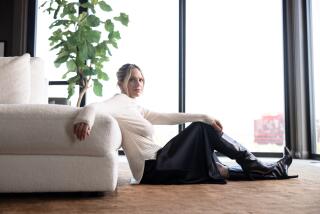Adult Students’ Rite of Passage Speaks to the Heart of Judaism
- Share via
Rabbi Lisa Hochberg-Miller was amazed that so many grown men and women of her congregation were willing to immerse themselves in the Jewish religion for a year in preparation for a bar or bat mitzvah, the religious rite of passage customarily made at age 13.
Last year, the rabbi gathered a group of individuals from various walks of life--and ages ranging from mid-30s to late-70s. They included an architect, poet, homemaker, drama teacher, therapist, college professor, artist, business owner and graduate student. Some were recent Jewish converts. Others, lifelong Jews who for various reasons did not become a bat mitzvah (for females) or bar mitzvah (for males) when they were younger.
Traditionally only 13-year-old boys could become a bar mitzvah, which translates to “a son of the commandments,” Hochberg-Miller explained. In 1922, the first girl became a bat mitzvah, “a daughter of the commandments.” Becoming either a bar or bat mitzvah involves emersion in the Hebrew language with the ultimate aim of being able to read from the Torah, an event confirming that the child has arrived at the age of religious responsibility.
The adult b’nai (plural for men and women) mitzvah began in the 1980s.
“It’s a recent phenomenon driven by older women who had missed the opportunity,” Hochberg-Miller said.
In her class of 17 women and two men, she and her students met weekly to study Jewish prayers and read Hebrew writing from the temple’s sacred Torah.
“It took a tremendous amount of effort,” Hochberg-Miller said. “Especially the last nine weeks. They totally immersed themselves and told me they would wake up at night with prayers going through their heads.”
During a Saturday morning service at Reform Temple Beth Torah in Ventura last month, all the students of the adult b’nai mitzvah class demonstrated to the congregation their proficiency in reading from the Torah.
Diana Boydstun, Barry Brenner, Elinor Chaum, Leslie Diamond, Bill Fulton, Sylvia Goldstein, Cindy Hansen, Laurel Hunter, Mary Ann Lish, Alison Mizraji, Penelope Murillo, Geri Pearl, Fern Perusse, Linda Rubenstein, Sharon Schill, Susan Sher, Reanne Singer, Chris Weber and Lisa Yanover were called before the Torah to read.
The adult b’nai mitzvah began during the regular Sabbath service after each student was presented with a tallit, a prayer shawl, by someone dear to them.
Perusse, 42, chose her 14-year-old son Dane to present her tallit to her because of the great help and support he had given her while she studied during the past year.
The Ventura resident’s son had his own bar mitzvah last year and knew what his mother was going through.
“It was fun to be able to teach my mother something for a change. She taught me to walk and talk and helps me with my homework,” Dane said.
Each tallit presented on the bima, an elevated area at the front of the sanctuary, was different. Some were simple, while others were ornate.
During the service, Hochberg-Miller and cantor Michael Anatole called up groups of students who took turns leading prayers in Hebrew.
Songs sang and led by Anatole--part of the weekly service--drew 300 congregants and friends and relatives of the b’nai mitzvah who filled the temple’s sanctuary and balcony.
During regular services the rabbi takes the Torah scrolls out and parades them around the congregation. When a child has a bar mitzvah or bat mitzvah he or she is given the honor of carrying the Torah. Since there were so many in the b’nai mitzvah class, they stood in a line and passed the scrolls, one to another, explained Hochberg-Miller.
Then came the moment when each student was called up to the Torah.
The sun shined through the sanctuary’s stained-glass windows and made a rainbow reflection on the wall behind those who were reading a special calligraphic Hebrew.
They had begun their studies by reading an English translation of passages that told the story of Abraham. As they read during the service, they used a silver pointer to keep their place as they moved on the unlined manuscript from right to left.
Each student gave a sigh of relief when his or her part was over.
“I feel elated and relieved this long preparation has finally come to fruition,” said Lish, a 55-year-old Oxnard resident. “This has been a gigantic step for me in my journey for a deeper spiritual understanding.”
Lish had been raised Catholic, but returned from a trip to Israel curious about Judaism, she said. Soon she began studying Hebrew.
A Hebrew class is a requirement for a b’nai mitzvah, said Rabbi Alan Greenbaum, of Reform Temple Adat Elohim in Thousand Oaks.
His temple and Reform Temple Beth Torah offer the classes every other year or as the need arises.
Greenbaum has just begun an adult Hebrew class and has 25 students. An adult b’nai mitzvah class will follow in January.
“It has been my experience that adults come to this class when they come to an awareness of the importance of their personal faith and the role they play in a religious community,” Greenbaum said.
Those who have a sense of pride in their heritage and want a deeper knowledge of Judaism will enjoy the work it takes to prepare for a b’nai mitzvah, he said.
“It is very special for one to have an opportunity to publicly declare his or her belief system and to make a very personal statement,” Greenbaum said.
“It has been worth all the hard work,” said Geri Pearl, a 74-year-old Oxnard resident. “I wanted to learn and I have done that and more. I’ve made wonderful friends.”
More to Read
Sign up for Essential California
The most important California stories and recommendations in your inbox every morning.
You may occasionally receive promotional content from the Los Angeles Times.












